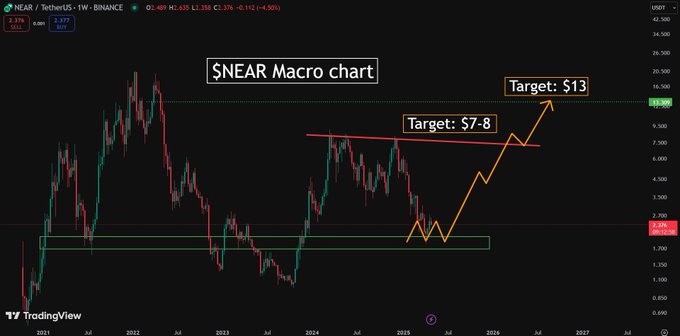As Bitcoin pursues $100K on enhanced optimism, crypto enthusiasts explore narratives that could fuel the upcoming broad-based rallies.
Let’s check why investors will watch NEAR and the viral PepeX in the coming sessions.
NEAR, “the Bitcoin of AI tokens,” eyes a potential breakout as a bullish structure aligns with optimistic chatter.
Meanwhile, PepeX’s advanced tokenization Launchpad grabs investor attention.
It has nearly $2 million in the ongoing presale.
NEAR hints at imminent breakouts
Near Protocol’s native coin exhibits a bullish price structure, suggesting potential upswings.
The token has secured solid grounds after months of subtle accumulations and consolidations.
Meanwhile, the expanding ecosystem and continued developments have kept the asset afloat.
Recently, Near Protocol expanded chain abstraction capabilities to Solana, TON, Aptos, Sui, and Stellar.
The announcement read:
This update represents a crucial step in NEAR’s chain abstraction architecture, broadening interoperability across diverse blockchain ecosystems and fostering a more unified development experience. The addition of EdDSA support is particularly valuable for developers working with high-throughput chains like Solana, TON, Aptos, and Sui.
NEAR trades at $2.35, mirroring the prevailing broad market performance.
Meanwhile, a solid reversal setup on its price chart drives optimism.
The favorable candle formations and increasing buying volume after March’s lower low hint at upside trends.
Analyst Solberg Invest predicts surges to $13, translating to an over 80% uptick from NEAR’s current price.
Besides price charts, NEAR boasts a solid foundation.
The $20 million AI fund project supports decentralized AI innovations.
Moreover, Near Protocol has Deutsche Telekom as its validator.
NEAR appears ready to shape decentralized technologies (in the long term) as it aims to integrate artificial intelligence tools into the blockchain infrastructure.
PepeX: AI tokenization and fair launches
Meme cryptocurrencies are shifting towards accrual innovation and utility, and PepeX appears at the center of this transformation.
With its AI-powered asset tokenization platform and focus on fair asset launches, PepeX looks to redefine a sector often attacked due to VC-centered tokenomics and insider trading deals.
The project distributes 95% of the available tokens to the public and only 5% to founders, which they might lose if PepeX fails.
The fair launch introduces transparency and legitimacy, which appear crucial in the growing cryptocurrency industry.
Moreover, PepeX’s AI-driven tool allows anyone to create and launch a token without technical expertise.
The project’s Whitepaper highlights:
PepeX is a neo-fair-launch platform where creativity and innovation are the only currencies that matter. Transparent, profitable for the community, and not a playground for insiders. No coding, no complex tokenomics – just pure creativity backed by real DeFi.
PepeX represents a movement toward decentralizing access to digital assets tools.
Imagine creating and launching your favorite token as simple as posting on social media sites.
Indeed, meme coins have done more in onboarding individuals into the cryptocurrency world than most specialized marketing campaigns.
PepeX leverages that while presenting genuine functionality.
PepeX trades at $0.0268, and analysts predict massive growth after its official launch.
You can visit here for more details about PepeX.
The post Best coins to buy: NEAR and PepeX revive the AI narrative appeared first on CoinJournal.




